Frost Heaving and Induced Pressure of Unsaturated Interfacial Zone between Gravel Ballast and Subgrade
Abstract
:1. Introduction
2. Materials and Methods
2.1. Gravel Ballast and Subgrade Soil
2.2. Frost Experiments
3. Results
3.1. Frost Heaving
3.1.1. Heaving Behavior
3.1.2. Summary of Frost Heaving Tests
3.2. Frost Heaving-Induced Pressure
3.2.1. Heaving Pressure Behavior
3.2.2. Summary of Frost Heaving Pressure Tests
4. Discussion
Level of Frost Heaving in Different Soil Types According to Degree of Saturation
5. Conclusions
- For pure gravel ballast, no frost heaving occurs when S is less than 55%. However, even pure gravel ballast experiences frost heaving as S increases. The induced pressure is dissipated within the soil network under fully confined conditions.
- The level of frost heaving increases as S and M increase. Depending on the mixture matrix, frost shrinkage is sometimes observed during the initial freezing phase. However, the mixture gradually frost-heaved. The initial frost shrinkage disappears as S increases. The level of frost heaving pressure under fully confined conditions also increases as S and M increase.
- The observed level of gravelly soils was lower than that of fine soils in this study compared to data reported previously in the literature. However, the frost potential increased as the proportion of frost-susceptible soil increased when there was sufficient water. Repeated freezing cycles can amplify the frost potential of gravelly soils. Therefore, a proper drainage system and prevention of fine intrusion are required to reduce frost damage in gravel ballast, particularly at the interfacial zone.
Funding
Informed Consent Statement
Data Availability Statement
Conflicts of Interest
References
- Raymond, G.P.; Gaskin, P.N.; Svec, O. Selection and Performance of Railroad Ballast. In Railroad Track Mechanics and Technology; Pergamon: Oxford, UK, 1978; pp. 369–386. [Google Scholar]
- Bezin, Y.; Farrington, D.; Penny, C.; Temple, B.; Iwnicki, S. The dynamic response of slab track constructions and their benefit with respect to conventional ballasted track. Int. J. Veh. Mech. Mobil. 2010, 48, 175–193. [Google Scholar] [CrossRef]
- Miura, S.; Takai, H.; Uchida, M.; Fukada, Y. The mechanism of railway tracks. Jpn. Railw. Transp. Rev. 1998, 3, 38–45. [Google Scholar]
- Paixao, A.M.; Fortunato, E.C.; Antunes, M.L. Emerging Trends for High-Speed Rail Track Superstructures—Ballastless Track as an Alternative To the Ballasted Track. In Proceedings of the 8th International Conference on the Bearing Capacity of Roads, Railways, and Airfields, Champaign, IL, USA, 29 June–2 July 2009; CRC Press: Champaign, IL, USA, 2009; pp. 1231–1241. [Google Scholar]
- Lee, S.; Jang, S.Y.; Kim, C.Y.; Ahn, E.J.; Kim, S.P.; Gwon, S.; Shin, M. Effects of Redispersible Polymer Powder on Mechanical and Durability Properties of Preplaced Aggregate Concrete with Recycled Railway Ballast. Int. J. Concr. Struct. Mater. 2018, 12, 69. [Google Scholar] [CrossRef]
- Lee, S.Y.; Kim, Y.C.; Kim, N.H.; Kim, M.S. Experimental Study about Reduction of Frost-heaving in Railway roadbed which using wasted tire chips. In Proceedings of the KSR Conference, The Korea Society for Railway, Changwon, Korea, 20 February 2010; pp. 633–639. [Google Scholar]
- Han, C.Y.; Lee, J.S.; Cho, K.H. The study about reduction of frost-heaving in railway small structures. In Proceedings of the KSR Conference, The Korean Society for Railway, Hoengseong, Korea, 20–22 October 2011; pp. 1129–1135. [Google Scholar]
- Duong, T.V.; Cui, Y.J.; Tang, A.M.; Dupla, J.C.; Canou, J.; Calon, N.; Robinet, A. Investigating the mud pumping and interlayer creation phenomena in railway sub-structure. Eng. Geol. 2014, 171, 45–58. [Google Scholar] [CrossRef]
- Hudson, A.; Watson, G.; Le Pen, L.; Powrie, W. Remediation of Mud Pumping on a Ballasted Railway Track. Procedia Eng. 2016, 143, 1043–1050. [Google Scholar] [CrossRef] [Green Version]
- Do, J.; Heo, S.B.; Yoon, Y.W.; Chang, I. Evaluating the liquefaction potential of gravel soils with static experiments and steady state approaches. KSCE J. Civ. Eng. 2017, 21, 642–651. [Google Scholar] [CrossRef]
- Li, A.; Niu, F.; Zheng, H.; Akagawa, S.; Lin, Z.; Luo, J. Experimental measurement and numerical simulation of frost heave in saturated coarse-grained soil. Cold Reg. Sci. Technol. 2017, 137, 68–74. [Google Scholar] [CrossRef]
- Long, X.; Cen, G.; Cai, L.; Chen, Y. Experimental Research on Frost Heave Characteristics of Gravel Soil and Multifactor Regression Prediction. Adv. Mater. Sci. Eng. 2018, 2018, 5682619. [Google Scholar] [CrossRef] [Green Version]
- Wang, T.L.; Yue, Z.R.; Ma, C.; Wu, Z. An experimental study on the frost heave properties of coarse grained soils. Transp. Geotech. 2014, 1, 137–144. [Google Scholar] [CrossRef]
- Wang, Q.; Liu, J.; Zhu, X.; Liu, J.; Liu, Z. The experiment study of frost heave characteristics and gray correlation analysis of graded crushed rock. Cold Reg. Sci. Technol. 2016, 126, 44–50. [Google Scholar] [CrossRef]
- Holtz, R.D.; Kovacs, W.D.; Sheahan, T.C. An Introduction to Geotechnical Engineering; Prentice-Hall: Englewood Cliffs, NJ, USA, 1981. [Google Scholar]
- Van Vliet-Lanoë, B.; Fox, C.A. Frost Action. In Interpretation of Micromorphological Features of Soils and Regoliths; Elsevier: Amsterdam, The Netherlands, 2018; pp. 575–603. [Google Scholar] [CrossRef]
- Ji, Y.; Zhou, G.; Hall, M.R. Frost heave and frost heaving-induced pressure under various restraints and thermal gradients during the coupled thermal-hydro processes in freezing soil. Bull. Eng. Geol. Environ. 2019, 78, 3671–3683. [Google Scholar] [CrossRef]
- Wu, D.; Lai, Y.; Zhang, M. Thermo-hydro-salt-mechanical coupled model for saturated porous media based on crystallization kinetics. Cold Reg. Sci. Technol. 2017, 133, 94–107. [Google Scholar] [CrossRef]
- Liu, Z.; Liu, J.; Li, X.; Fang, J. Experimental study on the volume and strength change of an unsaturated silty clay upon freezing. Cold Reg. Sci. Technol. 2019, 157, 1–12. [Google Scholar] [CrossRef]
- KRCS A015 07; Railroad Quality Specification for Gravel Ballast. Korea Railroad: Daejeon, Korea, 2017.
- ASTM D6913-17; Standard Test Methods for Particle-Size Distribution (Gradation) of Soils Using Sieve Analysis. ASTM International: West Conshohocken, PA, USA, 2017.
- ASTM D2487-17e1; Standard Practice for Classification of Soils for Engineering Purposes (Unified Soil Classification System). ASTM International: West Conshohocken, PA, USA, 2017.
- ASTM D854-14; Standard Test Methods for Specific Gravity of Soil Solids by Water Pycnometer. ASTM International: West Conshohocken, PA, USA, 2014.
- ASTM D698-12e2; Standard Test Methods for Laboratory Compaction Characteristics of Soil Using Standard Effort. ASTM International: West Conshohocken, PA, USA, 2012.
- Bai, R.; Lai, Y.; Pei, W.; Zhang, M. Investigation on frost heave of saturated—Unsaturated soils. Acta Geotech. 2020, 15, 3295–3306. [Google Scholar] [CrossRef]
- Gray, N. Water Technology, 3rd ed.; CRC Press: London, UK, 2017; ISBN 9781315276106. [Google Scholar]
- Cai, H.; Li, S.; Liang, Y.; Yao, Z.; Cheng, H. Model test and numerical simulation of frost heave during twin-tunnel construction using artificial ground-freezing technique. Comput. Geotech. 2019, 115, 103155. [Google Scholar] [CrossRef]
- She, W.; Cao, X.; Zhao, G.; Cai, D.; Jiang, J.; Hu, X. Experimental and numerical investigation of the effect of soil type and fineness on soil frost heave behavior. Cold Reg. Sci. Technol. 2018, 148, 148–158. [Google Scholar] [CrossRef]
- Wan, H.; Bian, J.; Wu, J.; Sun, X.; Wang, Y.; Jia, Z. Prediction of seasonal frost heave behavior in unsaturated soil in northeastern China using interactive factor analysis with split-plot experiments and GRNN. Water 2019, 11, 1587. [Google Scholar] [CrossRef] [Green Version]
- Wang, T.; Liu, Y.; Yan, H.; Xu, L. An experimental study on the mechanical properties of silty soils under repeated freeze—Thaw cycles Subgrade subsidence Road pavement cracks. Cold Reg. Sci. Technol. 2015, 112, 51–65. [Google Scholar] [CrossRef]
- Das, B.M.; Sivakugan, N. Fundamentals of Geotechnical Engineering; Cengage Learning: Stamford, CT, USA, 2016. [Google Scholar]
- Liu, X.Q.; Liu, J.K.; Tian, Y.H.; Shen, Y.P.; Wang, Q.Z. Effect of dynamic load and cooling path on the frost characteristics of saturated lean clay. Transp. Geotech. 2021, 31, 100645. [Google Scholar] [CrossRef]
- Lu, X.; Zhang, F.; Qin, W.; Zheng, H.; Feng, D. Experimental investigation on frost heave characteristics of saturated clay soil under different stress levels and temperature gradients. Cold Reg. Sci. Technol. 2021, 192, 103379. [Google Scholar] [CrossRef]
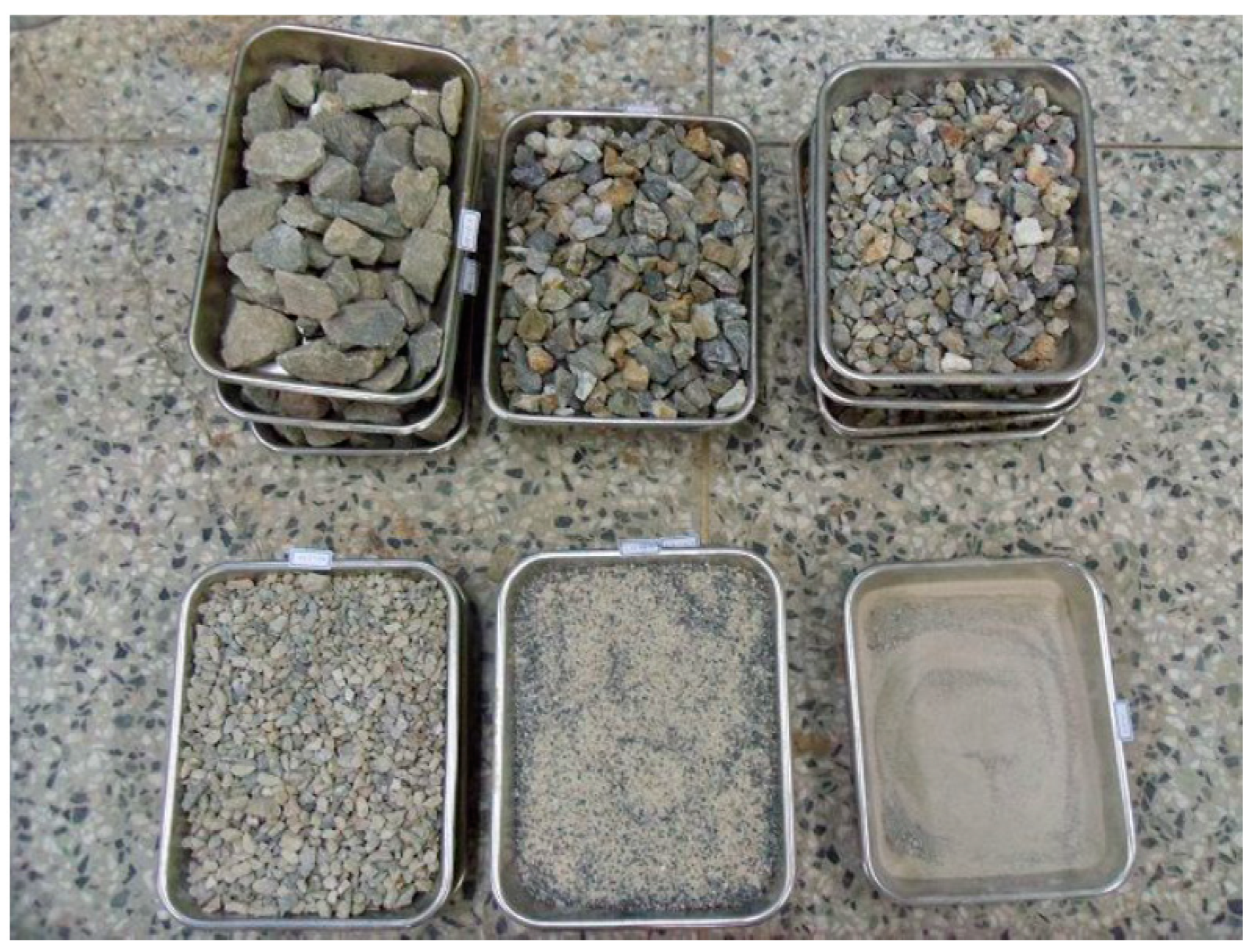
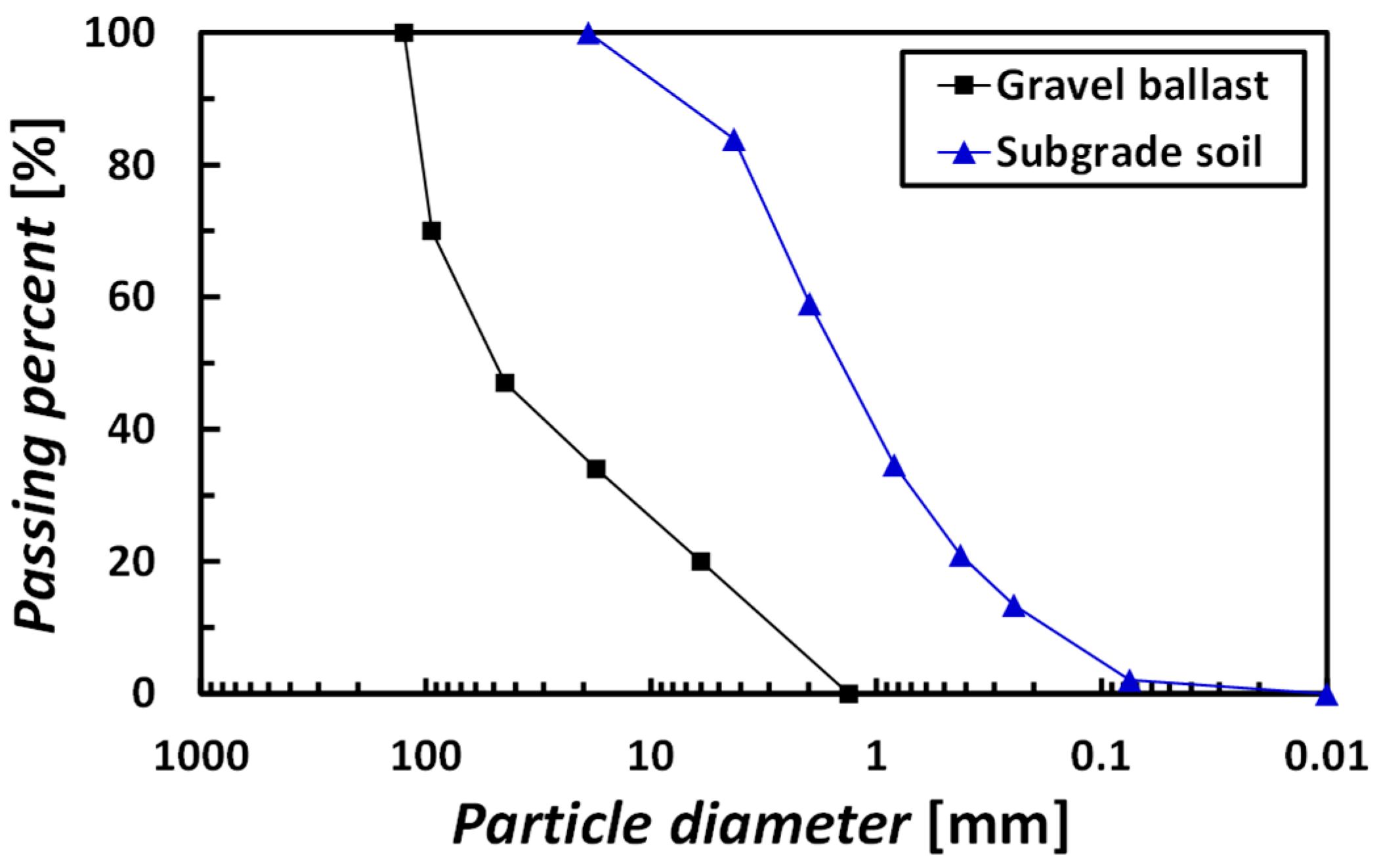

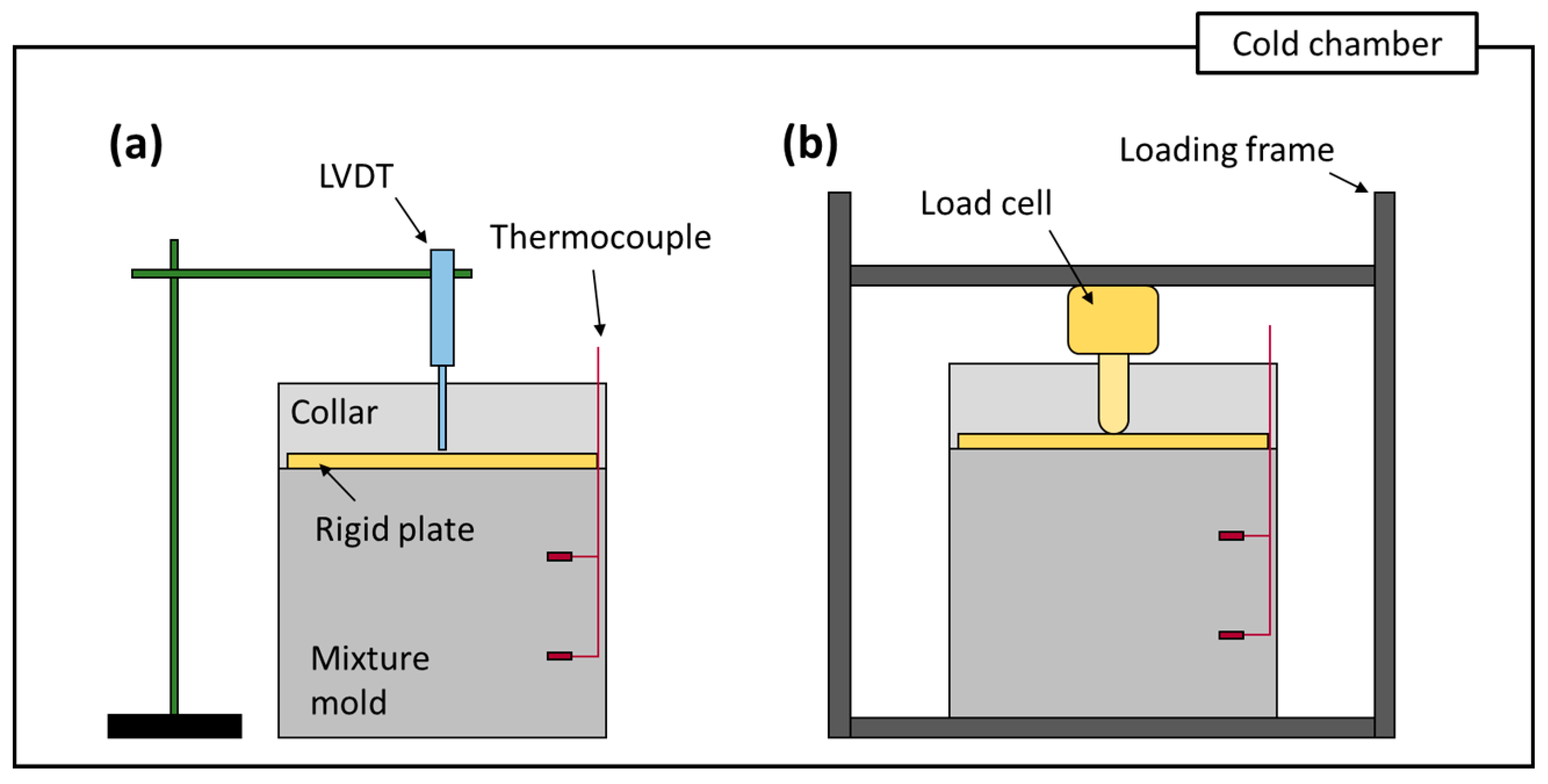


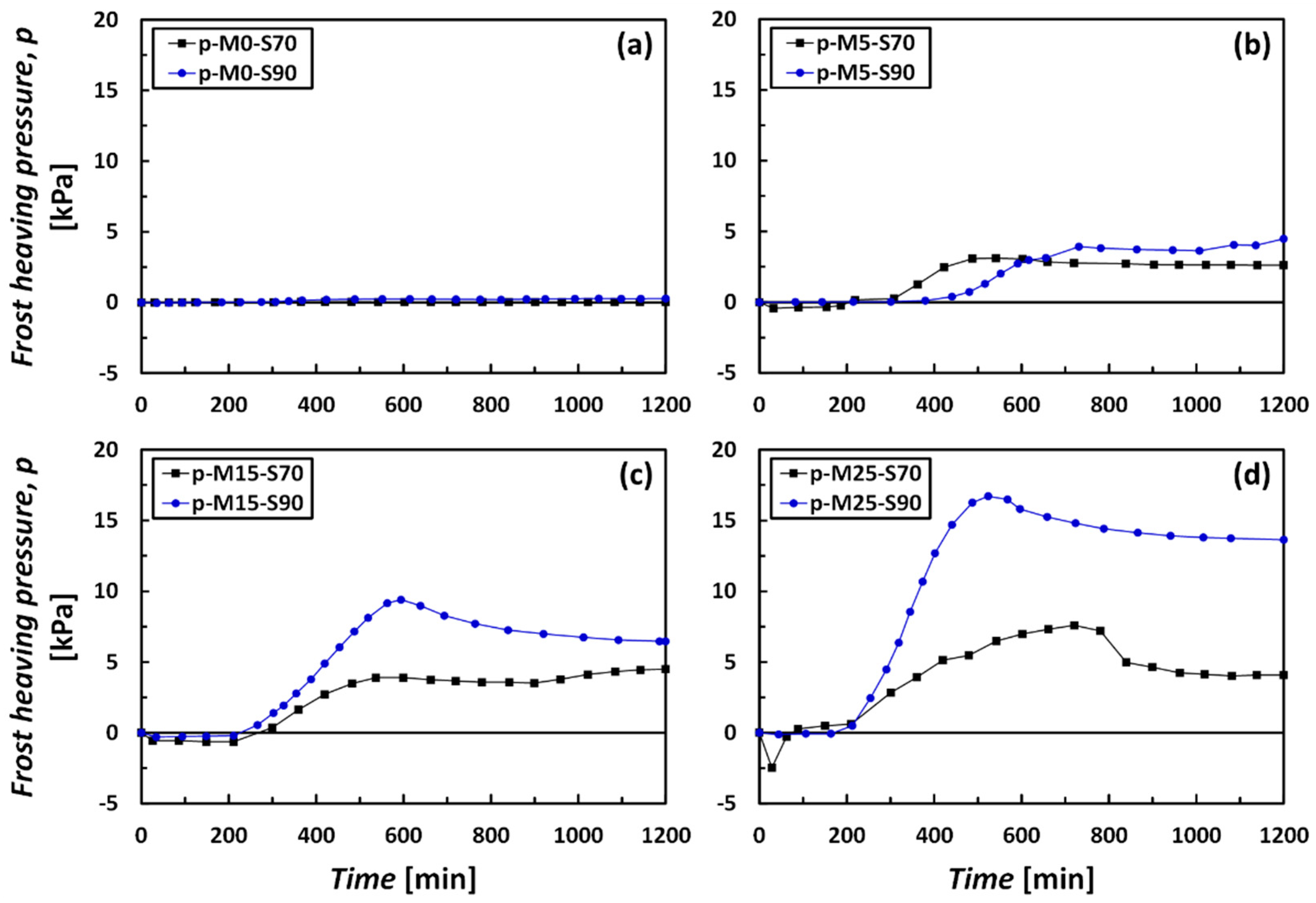
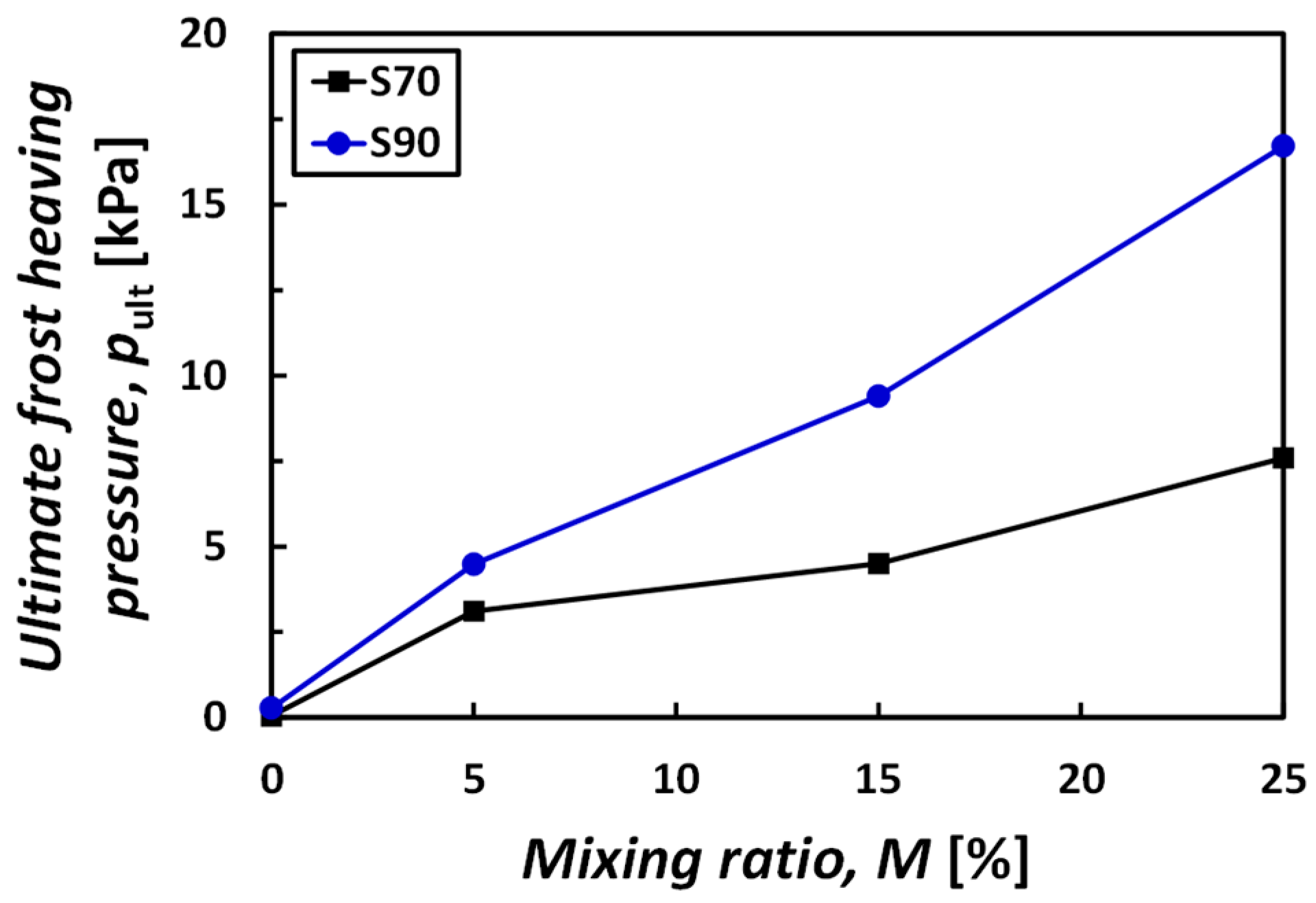

| Type | Gravel | Concrete |
|---|---|---|
| Typical design |  | 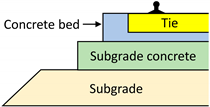 |
| Proportion | High | Low |
| Construction cost | Low | High |
| Track irregularity | High | Low |
| Noise during train | Low | High |
| Train vibration | High | Low |
| Maintenance | Frequent | Less |
| Repair | Easy | Difficult |
| Ventilation in tunnel | Need | Not need |
| Mud pumping | Exist | Not exist |
| Test Type | M [%] | S [%] | Test Name |
|---|---|---|---|
| Frost heaving | 0 | 70/80/90 | h-M0-S70/80/90 |
| 5 | h-M5-S70/80/90 | ||
| 10 | h-M10-S70/80/90 | ||
| 15 | h-M15-S70/80/90 | ||
| 20 | h-M20-S70/80/90 | ||
| 25 | h-M25-S70/80/90 | ||
| Frost heaving pressure | 0 | 70/90 | p-M0-S70/90 |
| 5 | p-M5-S70/90 | ||
| 15 | p-M15-S70/90 | ||
| 25 | p-M25-S70/90 |
Publisher’s Note: MDPI stays neutral with regard to jurisdictional claims in published maps and institutional affiliations. |
© 2022 by the author. Licensee MDPI, Basel, Switzerland. This article is an open access article distributed under the terms and conditions of the Creative Commons Attribution (CC BY) license (https://creativecommons.org/licenses/by/4.0/).
Share and Cite
Do, J. Frost Heaving and Induced Pressure of Unsaturated Interfacial Zone between Gravel Ballast and Subgrade. Appl. Sci. 2022, 12, 2811. https://doi.org/10.3390/app12062811
Do J. Frost Heaving and Induced Pressure of Unsaturated Interfacial Zone between Gravel Ballast and Subgrade. Applied Sciences. 2022; 12(6):2811. https://doi.org/10.3390/app12062811
Chicago/Turabian StyleDo, Jinung. 2022. "Frost Heaving and Induced Pressure of Unsaturated Interfacial Zone between Gravel Ballast and Subgrade" Applied Sciences 12, no. 6: 2811. https://doi.org/10.3390/app12062811
APA StyleDo, J. (2022). Frost Heaving and Induced Pressure of Unsaturated Interfacial Zone between Gravel Ballast and Subgrade. Applied Sciences, 12(6), 2811. https://doi.org/10.3390/app12062811






